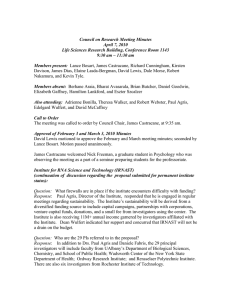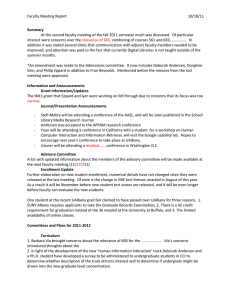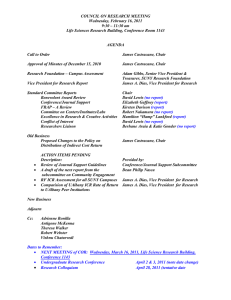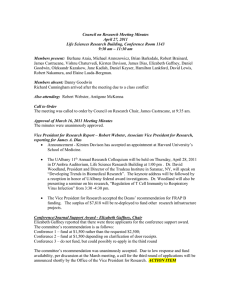Council on Research Meeting Wednesday, October 17, 2007
advertisement
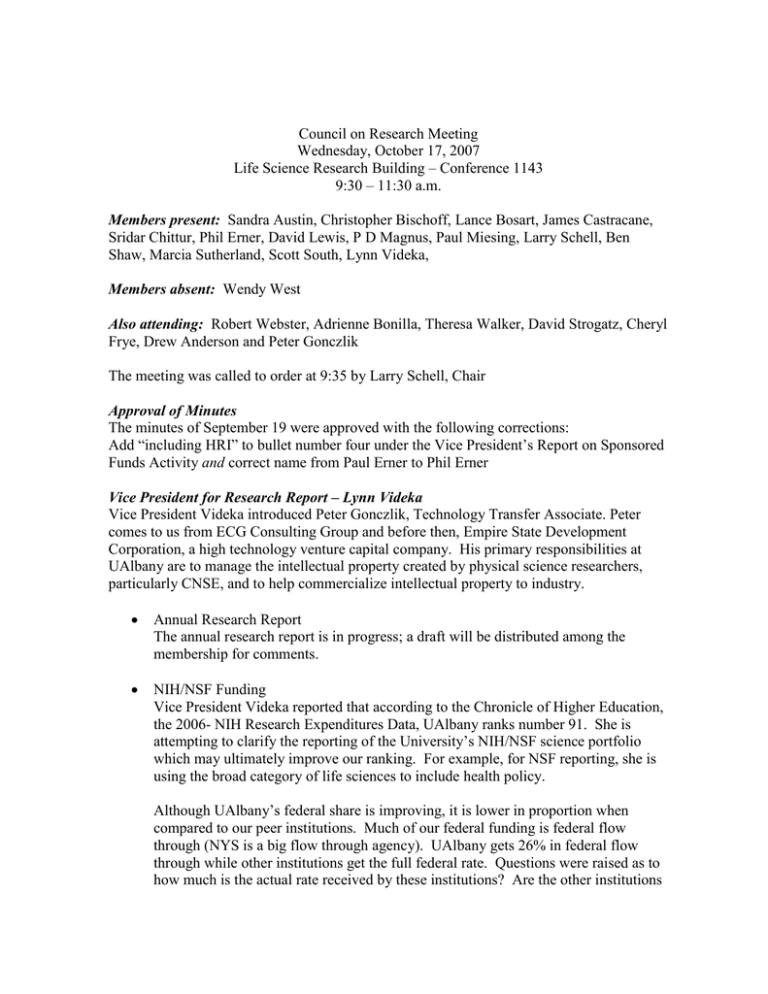
Council on Research Meeting Wednesday, October 17, 2007 Life Science Research Building – Conference 1143 9:30 – 11:30 a.m. Members present: Sandra Austin, Christopher Bischoff, Lance Bosart, James Castracane, Sridar Chittur, Phil Erner, David Lewis, P D Magnus, Paul Miesing, Larry Schell, Ben Shaw, Marcia Sutherland, Scott South, Lynn Videka, Members absent: Wendy West Also attending: Robert Webster, Adrienne Bonilla, Theresa Walker, David Strogatz, Cheryl Frye, Drew Anderson and Peter Gonczlik The meeting was called to order at 9:35 by Larry Schell, Chair Approval of Minutes The minutes of September 19 were approved with the following corrections: Add “including HRI” to bullet number four under the Vice President’s Report on Sponsored Funds Activity and correct name from Paul Erner to Phil Erner Vice President for Research Report – Lynn Videka Vice President Videka introduced Peter Gonczlik, Technology Transfer Associate. Peter comes to us from ECG Consulting Group and before then, Empire State Development Corporation, a high technology venture capital company. His primary responsibilities at UAlbany are to manage the intellectual property created by physical science researchers, particularly CNSE, and to help commercialize intellectual property to industry. Annual Research Report The annual research report is in progress; a draft will be distributed among the membership for comments. NIH/NSF Funding Vice President Videka reported that according to the Chronicle of Higher Education, the 2006- NIH Research Expenditures Data, UAlbany ranks number 91. She is attempting to clarify the reporting of the University’s NIH/NSF science portfolio which may ultimately improve our ranking. For example, for NSF reporting, she is using the broad category of life sciences to include health policy. Although UAlbany’s federal share is improving, it is lower in proportion when compared to our peer institutions. Much of our federal funding is federal flow through (NYS is a big flow through agency). UAlbany gets 26% in federal flow through while other institutions get the full federal rate. Questions were raised as to how much is the actual rate received by these institutions? Are the other institutions Page 2 – October 17 COR Minutes making a profit? Is the amount (not proportion) much smaller than our peers? Are our investigators playing second to other institutions? One of the challenges is finding peer institutions that are non-engineering and/or non-medical school. Our peers currently include such institutions as the three SUNY centers, Florida State University, University of California at Santa Cruz, University of California at Riverside, etc. In addition to federal flow through, she is looking at other agencies. Our indirect cost effective rate without industry is in the low 20s, but if we include all agencies, it is in the low teens (this is with or without Nanoscale). Bosart suggested that if the numbers are normalized, this may help when comparing our portfolio to other institutions. The Science Academy is another area that is being explored to determine their ranking of federal agencies. Strogatz cautioned that the rankings may be narrow in scope; for example, they do not include CDC funding. The report will be shared with Council when it is ready. Lynn will also distribute historical data on the University’s federal portfolio at a later date. East Campus The University is in the process of creating a new real estate holding company called UAlbany BioTech Development Corporation. This will be a 50lC25 that will form a partnership with UAlbany Foundation, Research Foundation of SUNY and UAlbany. The search for an executive director is currently underway. It is expected that the incumbent will help the University develop links between research and business and assist with the commercialization of inventions. In response to several questions raised regarding commercialization and economic development, Walker explained that around the world, university performance has been increasingly linked with economic vibrancy. The Bayh/Dole Act in 1980 led to opportunities for Universities to get into producing inventions, but how the inventions are marketed is left up to the institutions. University researchers create a lot of intellectual value that has importance in the normal creation of knowledge, but also has significant potential applications to the real world. Vice President Videka noted that UAlbany’s leadership is aware of the conflict or tension between the mission of the University and that of economic development. The leadership also understands the balancing of conflicts between multiple goals especially in light or available resources. The point was made that there is value in investing in and determining ways to support young faculty. Faculty want to get their creations out there, but also want to protect their rights. Page 3 – October 17 COR Minutes Vice President Videka emphasized that the University definitely plays a role in the economic development of this region. The College of Nanoscale Science and Engineering has transformed the economy in this region, so we already have a model. The region offers good schools, lower cost of living, etc. She encouraged everyone to raise this issue with presidential candidates, as it is important to the campus as a whole. New Investigators Orientation The New Investigators Orientation will be held on October 23, at 1:00 – 3:00 in the D’Ambra Auditorium, Life Science Research Building. The orientation is designed for new faculty and new investigators. The program will consist of a panel of senior and junior investigators who will discuss their experiences with obtaining funding. COEUS Update – Robert Webster Robert Webster reported that on-going training has occurred since June with about 200 participants taking at least one class. Training materials are available on http://coeus.albany.edu He noted that if proposals are being submitted to grants.gov, the budget must be completed within Coeus. Otherwise, a spreadsheet can be submitted. Although training will be on-going, intense training will diminish after Nov. 30. All faculty who will submit applications must go thru the training process. Bob noted that the Deans and Dept. Chairs have been informed that it is possible to bring the training to faculty who cannot attend. He reminded everyone that help can be received from http://coeus.albany.edu and/or your research administrator. There is an additional tool being developed called on demand that should be available in the future. Subcommittee Reports Committee on Centers/Institutes/Specialized Labs – Christopher Bischoff reported that the committee would like to review centers in relation to departments to which are most closely aligned. Vice President Videka strongly encouraged the committee to find a way to make sure the centers/institutes policy is implemented. The committee will need to work closely with the University Assessment Council Old Business None New Business None Meeting adjourned at 10:45 am Submitted by Janice Bogan
